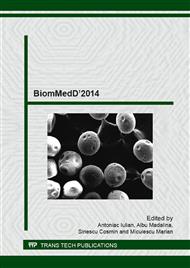p.238
p.243
p.249
p.255
p.262
p.270
p.274
p.280
p.286
The Assessment of Enamel Demineralisation by Fluorescent Light in Fixed Orthodontics
Abstract:
The brackets collating technique and microbial factors increase the risk for enamel demineralization in patients with fixed orthodontic appliance. The aim of this study was to determine the risk level of enamel demineralization in fixed orthodontic device bearers. The enamel demineralization was assessed in 187 patients by measuring dental structure by fluorescent light. The measurements were performed with the DIAGNOdent Pen 2190 (KaVo, Biberach, Germany). Except canines which remain in the risk 1 category, without enamel demineralization, the other investigated teeth may have a medium demineralization degree The values recorded with fluorescent light on canine enamel showed low and insignificant differences (p>0.05) as a result of fixed orthodontic appliances, classifying these teeth as healthy teeth with enamel integrity or with low enamel demineralization. The molars presented significantly increased values in the study group as compared to the control group (p<0.05). 6 years molars had a marked predisposition to demineralization and caries as compared to frontal group teeth, after fluorescent light measurements. The measurements include these teeth in the medium to high risk for dental caries. The DIAGNOdent, due to its capacity to determine the demineralization degree of dental surfaces, may be used to monitor patients and to prevent the occurrence of dental caries during fixed orthodontic treatments.
Info:
Periodical:
Pages:
262-269
Citation:
Online since:
March 2015
Keywords:
Price:
Сopyright:
© 2015 Trans Tech Publications Ltd. All Rights Reserved
Share:
Citation:


